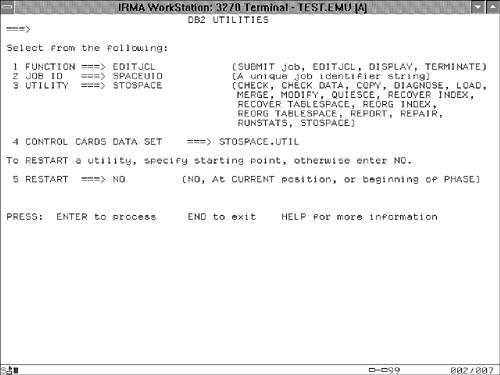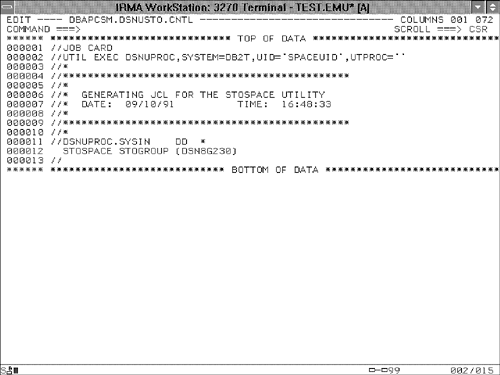Generating Utility JCL
| < Day Day Up > |
| In this chapter, all the sample JCL for the online utilities use DSNUPROC , a generic utility procedure supplied with DB2. Recall from Chapter 18, "The Doors to DB2," that online DB2 utilities can be controlled by DB2I option 8. The DB2I utility panels are shown in Figures 30.1 and 30.2. JCL to execute DB2 utilities can be generated by these DB2I panels. Figure 30.1. DB2I utility JCL generation panel 1. Figure 30.2. DB2I utility JCL generation panel 2. The first panel, shown in Figure 30.1, is set to generate JCL for the STOSPACE utility. The second panel, shown in Figure 30.2, provides additional information used by certain DB2 utilities. If the first panel were set to generate JCL for the COPY , LOAD , or REORG utilities, the second panel would prompt the user to enter data set names required for those utilities. The DB2I utility JCL generation panels provide four basic options:
The DISPLAY and TERMINATE options are merely menu-driven implementations of the DB2 -DISPLAY and - TERM commands. The SUBMIT and EDITJCL options provide automated DB2 utility JCL generation and submission. The DB2I utility program provides only rudimentary DB2 utility JCL, however. It works as follows :
The DB2I utility generator displays the output messages shown in Figure 30.3 when Enter is pressed and the request is processed . Figure 30.3. DB2I JCL generation output messages. The JCL generated by DB2I for the STOSPACE utility is shown in Figure 30.4. Generating JCL for a utility each time it is required, however, can be cumbersome. Many users create a partitioned data set containing sample utility JCL that they can modify as needed. The examples in Part VI can be used as templates for the creation of DB2 utility JCL for use in your shop. Figure 30.4. Generated JCL for the STOSPACE utility. Each online utility is associated with a utility identifier, or UID, that is passed to DSNUTILB as a parameter to uniquely identify the utility to DB2. Two utilities with the same UID cannot execute concurrently. The DSNUPROC procedure requires the specification of override parameters to function properly. These parameters should be coded as follows:
|
| < Day Day Up > |
EAN: 2147483647
Pages: 388